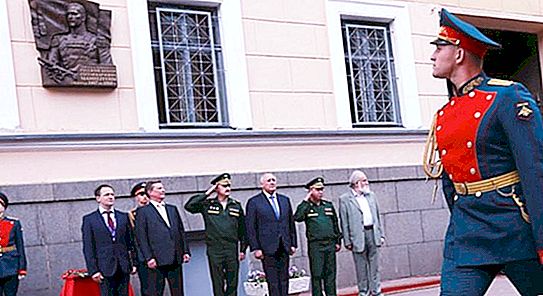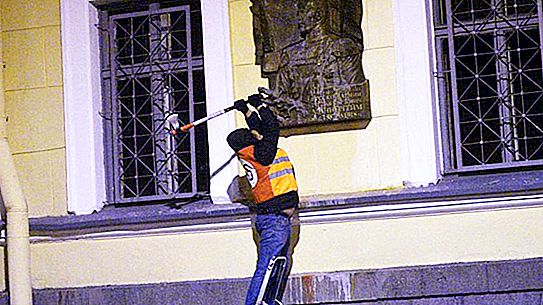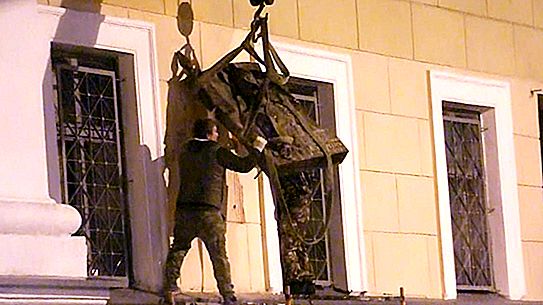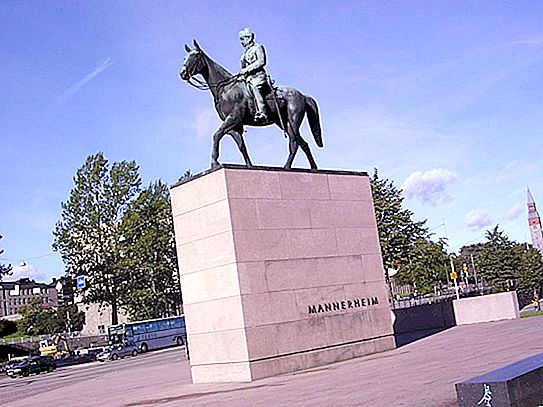The Mannerheim Monument is a memorial sign, the installation of which caused great controversy in St. Petersburg. It appeared in 2016, but was dismantled after a few months. The Finnish military leader and politician is still a controversial figure, historians cannot give an unambiguous assessment of his work today. In this article we will talk about the vicissitudes around the veneration of his memory in our country and the figure of the field marshal.
Disputes about the personality of the general
The installation of the Mannerheim monument in 2016 in St. Petersburg was held in a festive atmosphere. They decided to dedicate a memorial plaque to the Finnish field marshal, which appeared on the house number 22 on Zakharyevskaya street in the Northern capital. The ceremony was attended by Sergei Ivanov, who at that time held the post of head of the presidential administration of Russia.
At the same time, the installation of the Mannerheim monument in St. Petersburg immediately raised questions from many. His figure today remains controversial and difficult for Russian history. This is a Russian general of Finnish descent, a successful reconnaissance and cavalryman, adherent of the monarchy. His fate changed dramatically after the October Revolution.
The civil war that followed the coming to power of the Bolsheviks, in fact, split the empire into two warring parties. Some began to support the Reds, others - White. Among the opponents of Lenin and his party there were many who, until the end of their lives, maintained hatred for the communist regime they had built. Others in the 20-40s of the twentieth century changed their attitude towards the Bolsheviks, some devoted their future lives to the construction of new states formed on the outskirts of the Russian Empire. Karl Mannerheim also belongs to the latter category.
short biography

To understand what events led to the installation of the Mannerheim monument in St. Petersburg, you need to imagine what his biography was.
Karl Gustav Emil Mannerheim was born in 1867 on the territory of the Grand Duchy of Finland, which at that time was part of the Russian Empire.
When the young man was 13 years old, his father left the family. Having gone broke, he went to Paris. A year later, his mother died. A military career seemed to Gustav the most promising. At the age of 15, he entered the cadet corps, from which he was expelled in 1886, having gone to AWOL.
The following year, Mannerheim entered the cavalry school in St. Petersburg. To do this, he intensively studies the Russian language, has been studying with private teachers in Kharkov for several months. At 22, he graduated from college with honors, receiving an officer rank.
In Japan and China
In the Russian army, Mannerheim served from 1887 to 1917. In 1904, he was sent to the Russo-Japanese War. At first, the officer’s units are left in reserve. Then Commander-in-Chief Kuropatkin nevertheless decides to use them in the cavalry raid on Yingkou in order to seize the Japanese port with ships, to blow up the railway bridge in order to cut off communications between Mukden and Port Arthur, which had already been captured by then.
Due to various unfavorable factors, the attack on Yingkou was unsuccessful, the Russian army was defeated. At the same time, Mannerheim's division was never involved.
In February 1905, the general’s life was in jeopardy. His squad came under intense shelling. The orderly was killed, and Mannerheim himself was taken out of the battlefield by the wounded stallion Talisman, who died shortly afterwards.
From 1906 to 1908, the general spent on a research expedition in China. According to its results, he was admitted to the honorary members of the Russian Geographical Society.
Mannerheim commanded a cavalry brigade in World War I. For the battle at Krasnik he was awarded the St. George's Arms.
He distinguished himself during the crossing of the San River, took part in the Warsaw-Ivangorod operation, as a result of which the Austrian-German army was seriously defeated.
After the collapse of the empire
The news of the abdication of Emperor Nicholas II from the throne found him in Moscow. Mannerheim reacted negatively to the revolution, remaining a convinced monarchist until the end of his life.
The general himself increasingly thought of dismissal from military service due to the progressive collapse of the army. He repeatedly appealed to the Provisional Government to take more radical measures to combat this.
After the October Revolution, he called for resistance, but to his surprise, he came across complaints from representatives of the higher Russian society that they were not able to resist the Bolsheviks.
After that he went to Finland to support the independence she had just gained. Mannerheim was appointed commander in chief. He managed in a short time to form the 70, 000th army, which won the Civil War on the territory of this country. The Red Guard retreated to Russia.
After the surrender of Germany, he was appointed interim head of state. He sought international recognition of the independence of Finland. Mannerheim also supported the White movement in Russia, hatched plans for a campaign against Petrograd, but this did not lead to anything. In 1919, he lost the presidential election, left the country.
Soviet-Finnish War

He returned to his homeland in the 30s, heading a defense committee. Under his leadership, the Finnish troops withstood the first blow of the Red Army in the war with the Soviet Union of 1939-1940. As a result, a peace agreement was signed, according to which Finland lost 12% of its territory.
After that, the general began the construction of a new line of fortifications, which went down in history as the Mannerheim line. In July 1941, Finland launched an offensive against the USSR in alliance with Germany. Having advanced to Petrozavodsk, he ordered the troops to take up defense on the historical Russian-Finnish border on the Karelian Isthmus.
As part of the Vyborg-Petrozavodsk operation in 1944, Finnish troops were driven back. Mannerheim became president instead of retired Ryti. After that, he made a decision to withdraw from the war and sign a peace treaty with the USSR.
In March 46th, resigned due to health reasons. Avoided prosecution for liaising with the Nazis. In 1951, he died after surgery in connection with a stomach ulcer.
Reasons for installing a plaque

Sergey Ivanov tried to explain the reasons for the installation of the Mannerheim monument in Russia at its opening ceremony in 2016 on the facade of the building of the Military Academy of Logistics and Equipment. According to him, this is an attempt to overcome the split that has emerged in Russian society. The split associated with various interpretations of the events of the October Revolution.
Ivanov emphasized that until 1918 the general served Russia faithfully, therefore he considered the appearance of the monument to Mannerheim to be justified.
We know what happened next, and no one is going to dispute the subsequent Finnish period of history and Mannerheim’s actions, no one intends to whitewash this period of history. In general, everything that happened is one more proof of how the October Revolution dramatically changed the life of many people, a century of which we will celebrate in a year. But at the same time, one should not forget that worthy service of General Mannerheim, which he held in Russia and in the interests of Russia, ”Ivanov emphasized.
Vandal actions

At the same time, the appearance of the Mannerheim monument in St. Petersburg was regarded very negatively by many. Within a few days, the plaque was attacked by vandals. The plate was doused with paint. The board was washed by removing the polyethylene that covered it.
However, after a few years, the act of vandalism repeated. The Mannerheim Monument was again doused with paint.
It is noteworthy that at the same time, the Military Engineering University and the State Museum of Urban Sculpture officially declared that the memorial sign had nothing to do with them.
Dismantling

This story ended in October. The plaque was dismantled from the building of the Military Academy. Representatives of the Russian military-historical society, who were the initiators of the installation, said that it would be transferred to the museum of the First World War, located in Tsarskoye Selo.
Opponents of perpetuating the memory of the commander of the time of the Russian Empire and a prominent Finnish statesman not only repeatedly doused her with paint, but also turned to the court.
Monument in the Finnish capital
In Finland, the attitude to the field marshal is mostly positive. The Mannerheim Monument in Helsinki is one of the main attractions of the city. This is a monumental equestrian statue installed on the avenue named after him.
Tourists can see in many photos a monument to Mannerheim in Helsinki. It is a bronze statue of a field marshal on a horse almost 5.5 meters high. It is mounted on a granite rectangular pedestal.
Installation history

The appearance of the monument to the outstanding military leader was discussed in the 1930s, but then this idea was never realized. They returned to the project only after the death of the field marshal.
As a result of the competition, the famous Finnish sculptor Aimo Tukiainen became the author of the project. The grand opening took place in 1960 on the 93rd anniversary of the birth of the Marshal.
Since 1998, another attraction of present-day Helsinki, the Kiasma Museum of Contemporary Art, has been built next to the monument.




